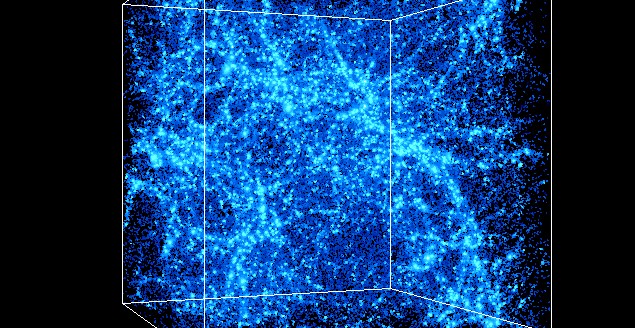Arguably the biggest science story of the week was the discovery of material evidence of dark matter. In this two-part article, two lead researchers on the report explain their findings and significance of the work. Their accounts are full of–besides beautiful explanations of cutting-edge physics research in layman’s terms–potent philosophy and enthralling sentiment about what these scientists are doing and what will come.
Setting out with the hypothesis that dark matter occasionally though rarely decays, European physicists pointed the European Space Agency’s XMM-Newton telescope at faraway galaxies to seek evidence of the common, though never seen, material that makes up an estimated 80 percent of our universe–in signal anomalies. In his explanation of the recent work, researcher Dr Oleg Ruchayskiy pointed to the era we are now entering, in which our vision and understanding will reach what we have not before known–both in terms of nature and of time.

“Dark structures that surround us will become ‘visible,'” Dr. Oleg Ruchayskiy, physicist at the École Polytechnique Fédérale de Lausanne (EPFL) and one of the authors of the study, told The Speaker. “Dark matter distribution is not expected to be perfectly smooth and its clumps and streams–they carry important information about the past of the Milky way or the Local Group. We will be able to visualize and maybe even tell the story of ‘our Galactic past.’
“This will be the epoch of ‘astronomical archaeology–looking at the events that happened a billion years ago.”
“The fact that this can be possible–to explore by the power of our minds the regions of space and periods of time, incomparable with the lifespan of humans–isn’t it beautiful?”
Read more: Dark matter signals, part two: Boiarskyi explains
Ruchayskiy commented on the kinds of improvements that were in store for humanity as our ability to see our universe was expanded to the perception of dark matter.
“Another thing about our research: if this signal is real dark matter decay–we will soon be able to build ‘dark matter telescopes.’ We will be able to do 3D tomography of our own galaxy and of nearby Universe. We will even be able to look into the past of our Universe.
Ruchayskiy explained the teams recent work.
“We were testing the hypothesis that this particle is _the same_ in different galaxies and in the galaxy clusters. Otherwise it would be very difficult to cross-check this signal.”
The physicist provided details about what the signal was that they found–how it was characterized and where it was located–and about the course of the study, which happily coincided with similar results from a completely separate team of physicists.
“Just to give you some background info. We were looking at X-ray spectra of galaxies and galaxy clusters. X-rays do not pass through the atmosphere, therefore all X-ray satellites are in space. So, the data is just files. In essence, the file is very simple: it tells you how many X-ray photons of a given energy had arrive from a given direction.
“It is more or less known how the X-ray signal from a galaxy should look. That is, ‘given X photons of energy 1 keV, we expect Y photons of energy 2 keV,’ etc. This is called ‘an X-ray spectrum of a galaxy’–or any other object.
“So, we were analyzing the spectrum of the Andromeda galaxy we found that there are ‘extra photons’ at energy around 3.5 keV. Several hundreds of them.
“This was not an “accident”–we were looking for these photons. We had a hypothesis, that dark matter particles are not stable, but occasionally decay. This happens very rarely. Any given particle has a probability of something like 1/billion to decay. But in a galaxy like our there are 10^70 such particles, so the resulting signal may be sizable. We searched for such signal for many years–and so did other groups–so we knew that it should be small…
“We found such a signal in Andromeda.
“A signal in one particular object could be anything: fluctuation, emission of ions, instrumental error. So, we looked at the data from a different object–the Perseus galaxy cluster. The galaxies and galaxy clusters have very different X-ray emissions. But masses of both types of objects are ‘dark matter dominated.’ So, seeing a line there was necessary. And we did find the signal. Moreover, we saw that the signal is redshifted–as Perseus is farther away from us–which excluded the instrumental origin of the signal. We saw that the signal’s intensity scales correctly (because the dark matter mass in Perseus cluster is different from that of Andromeda galaxy). We saw that signal becomes weaker as one goes to the outskirts of the cluster because dark matter is more concentrated towards the center — all this was consistent with the decaying dark matter hypothesis.
“Later we did another work where we have found a similar line from the center of our own Galaxy, the Milky Way. And again, its intensity fell into the predicted range.
“Independently from us and at the same time–even couple of days earlier–another group from Harvard CfA/NASA–you probably had seen the press releases of their result–had found a signal at the same energy in various galaxy clusters–both nearby and distant. Their work is completely independent, uses different observations. This is of course extremely important, that this are the independent results of two groups. And that these groups confirm each other–we haven’t seen each other’s works prior to publication on arXiv.”
Next the team will probe space for signals that would corroborate their hypothesis.
“Our strategy now is: find this signal from many dark matter dominated objects, show that its intensity is proportional to the total amount of dark matter in each object.”
Ruchayskiy elaborated on the breadth of work that remained to fill in the full picture of dark matter–namely the possibility of various types of dark matter, which we asked him about.
“Testing a hypothesis that this is only one component of dark matter and there are other types of particles would be harder, because than we need to know whether a portion of decaying particles changes from object from object and this depends on the model of dark matter.
“[W]e were specifically looking for these particles and for this type of signal. We did not know the energy, so we were scanning the energies.
“So, this road, from an idea that dark matter particle could be unstable to seeing an actual signal–it is breathtaking. The fact that people can grasp with their minds something about the whole Universe–it is very fascinating for me. And any ‘predictions’ that becomes a ‘confirmed signal’–this is very impressive. It’s a feeling that is hard to express. Of course, our signal is not unique in this aspect. Every scientific discovery is like that. Which makes it even more fascinating.”
The report, “An unidentified line in X-ray spectra of the Andromeda galaxy and Perseus galaxy cluster,” was completed by A. Boyarsky, O. Ruchayskiy, D. Iakubovskyi, and J. Franse, and was published on the Cornell University website.
Read more: Dark matter signals, part two: Boiarskyi explains
